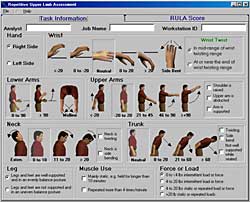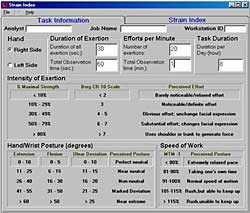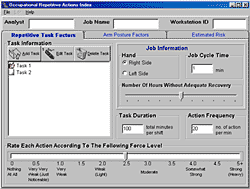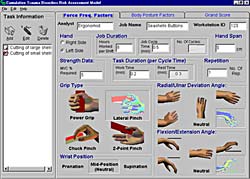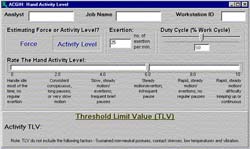ErgoIntelligence™ Upper Extremity Assessment (UEA)
The ErgoIntelligence™ Upper Extremity Assessment (UEA) suite of tools incorporates a variety of tools including RULA, REBA, Strain Index, Occupational Repetitive Actions Index (OCRA) and the Cumulative Trauma Disorders Risk Index.
RULA (Rapid Upper Limb Assessment)
RULA provides a rapid assessment of the musculoskeletal loads on workers due to posture, repetition and force. It aids in evaluating jobs or tasks that may expose workers to upper limb disorders (neck, shoulder, upper and lower arms, and hand). RULA accomplishes these goals by providing a "Grand Score" which can be compared to four Action Level:
Action level 1
A score of 1 or 2 indicates that posture is acceptable if it is not maintained or repeated for long periods.
Action level 2
A score of 3 or 4 indicates that further investigation is needed and changes may be required.
Action level 3
A score of 5 or 6 indicates that investigation and changes are required soon.
Action level 4
A score of 7 indicates that investigation and changes are required immediately.
REBA (Rapid Entire Body Assessment)
REBA was specifically designed to assess various unpredictable working postures found in health care and other service industries. The advantages of REBA are:
- A postural analysis system that is sensitive to musculoskeletal risks in a variety of tasks.
- The assessment techniques divide the body into segments to be coded individually, with reference to movement planes. REBA also includes a coupling/grip variable to evaluate the handling of loads.
- REBA provides a scoring system for muscle activity caused by static, dynamic, rapid changing or unstable postures.
- The final REBA score provides an action level with an indication of urgency.
Strain Index (SI)
The Severity Index (SI) is a score value based on a multiple of six variables: intensity of exertion, duration of exertion, efforts per minute, hand/wrist posture, speed of work and duration of task. The variables and score in the SI are derived from physiological, biomechanical, and epidemiological principles. Moore & Garg (1995) conducted a study in the poultry industry using the SI and found that, as the SI score increased, the mean incidence rate for distal upper extremity disorders also increased. Based on these findings, they recommended a cut-off score of 7 for the SI, as an identification criterion to determine high-risk jobs for distal upper extremity disorders.
Occupational Repetitive Actions Index
The Concise Exposure Index (OCRA) is a measurement tool that quantifies the relationship between the daily number of actions actually performed by the upper limbs in repetitive tasks, and the corresponding number of recommended actions. The recommended actions are calculated on the basis of a constant (30 actions per minute), which can be diminished, case-by-case, as a function of the presence and characteristics of the other risk factors (force, posture, additional elements, and recovery periods). Based on preliminary data, it is suggested by the author that an OCRA of >4 should be considered as a high-risk job. An index of 0.8 to 4 is an intermediate risk job.
Cumulative Trauma Disorders Risk Index
This cumulative trauma disorder risk assessment model for the upper extremities (termed the CTD Risk Index) was developed over the course of ten years of research with over forty member companies of the Center of Cumulative Trauma Disorders Research at the Pennsylvania State University. These companies included meat packers, poultry processors, garment manufacturers, metal fabricators and manufacturers of a variety of products. The final risk index is the predicted incidence rate (based on 200,000 working hours) for a cumulative trauma disorder.
The model is unique in that it uses quantitative data such as hand motion frequencies and forces together to obtain a frequency factor score that is reflective of the strain imposed on the muscles and tendons of the wrist. Gross upper extremity postures are included in a posture factor score and various minor job stressors are included as a miscellaneous factor score.
The variables and score in the CTD Risk Index are derived from physiological, biomechanical, and epidemiological principles.
Advantages
- Provides a quick method of screening a working population for exposure to a likely risk of work-related upper limb disorders.
- Allows for the identification of multi-factorial risk factors (i.e. combined effect of muscular effort or force, working posture, and performing repetitive work).
- Grand scores can be helpful in the communication of problems and decision upon the priority for investigations and the changes to be conducted in the workplace.
- This assessment tool can allow re-assessing any changes in musculoskeletal loading after modifications to the workplace or workstation.
- Grand score is related to upper limb disorders.
ACGIH HAL
The ACGIH HAL allows the analyst to calculate the Threshold Limit Value (TLV) and the Action Level (AL) for normalized peak force. The analyst can calculate or obtained the TLV/AL of the normalized peak force by entering the value of the hand activity level.
ACGIH HAL is an ergonomic assessment tool intended for "mono-task" jobs performed for 4 or more hours per day. (A mono-task job involves performing a similar set of motions or exertions repeatedly, such as working on an assembly line or using a keyboard and mouse). The main focus of the ACGIH HAL assessment tool is to allow analyst to calculate the TLV of the hand, wrist and forearm (i.e. distal upper extremity). The TLV specifically considers average hand activity level and peak hand force.
HAL is based on the frequency of hand exertions and the duty cycle (distribution of work and recovery periods). HAL can be determined with ratings by a trained observer, or calculated using information on the frequency of exertions and the work/recovery ratio.
A peak hand force is normalized on a scale of 0 to 10, which corresponds to 0% to 100% of the applicable population reference strength. Peak force can be determined with ratings by a trained observer, rated by workers using a BORG scale, calculated using biomechanical methods, or measured using instrumentation (e.g., hand dynameters or electromyography).
Download ErgoIntelligence UEA 30-Day Trial Version
ErgoIntelligence UEA runs on Windows XP, Vista, Windows 7, 8 and 10.
Click here to request an ErgoIntelligence UEA 30-day trial.
NOTE: Software trials are provided for evaluation only prior to possible purchase by those involved in the evaluation and decision process. We also provide them to students when the university has purchased the software and the trial is coordinated thru academic staff.



